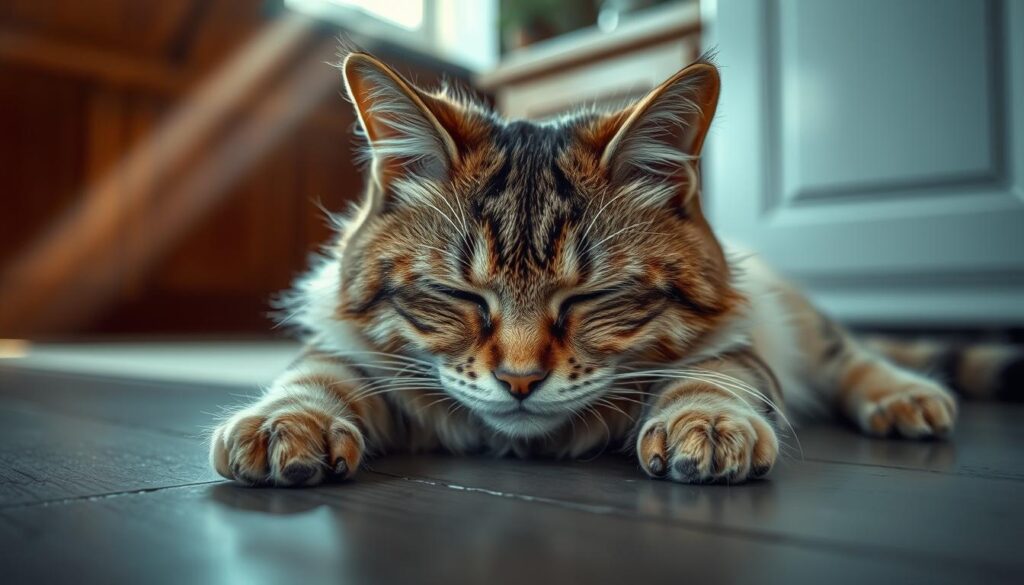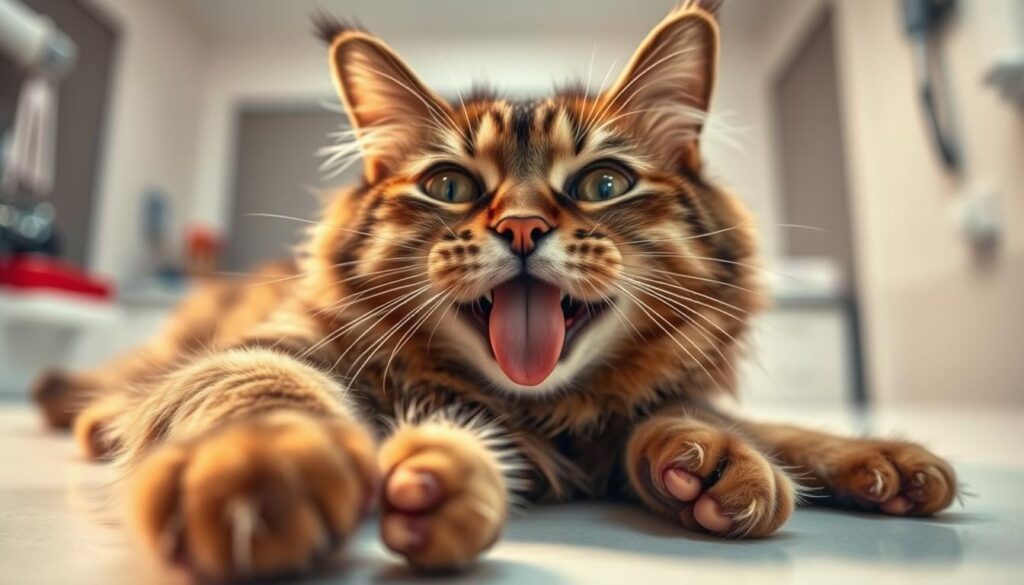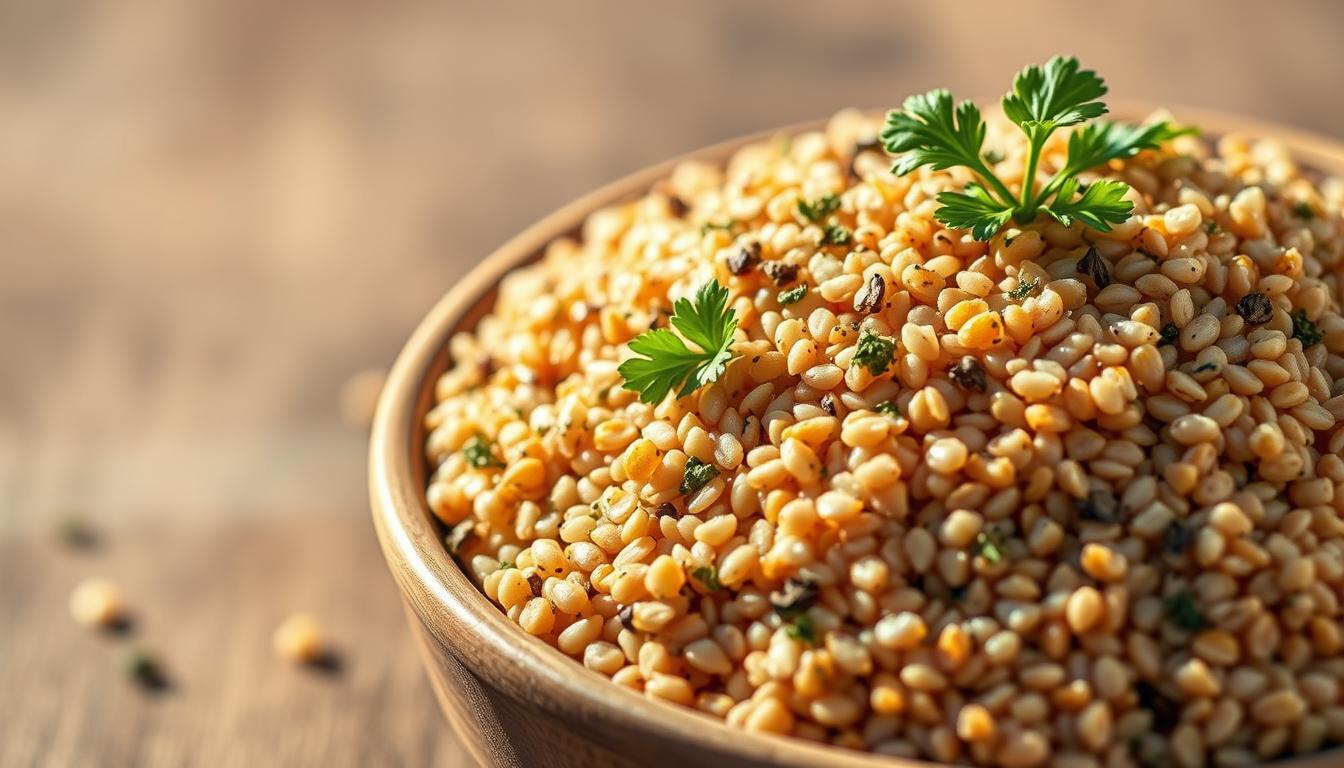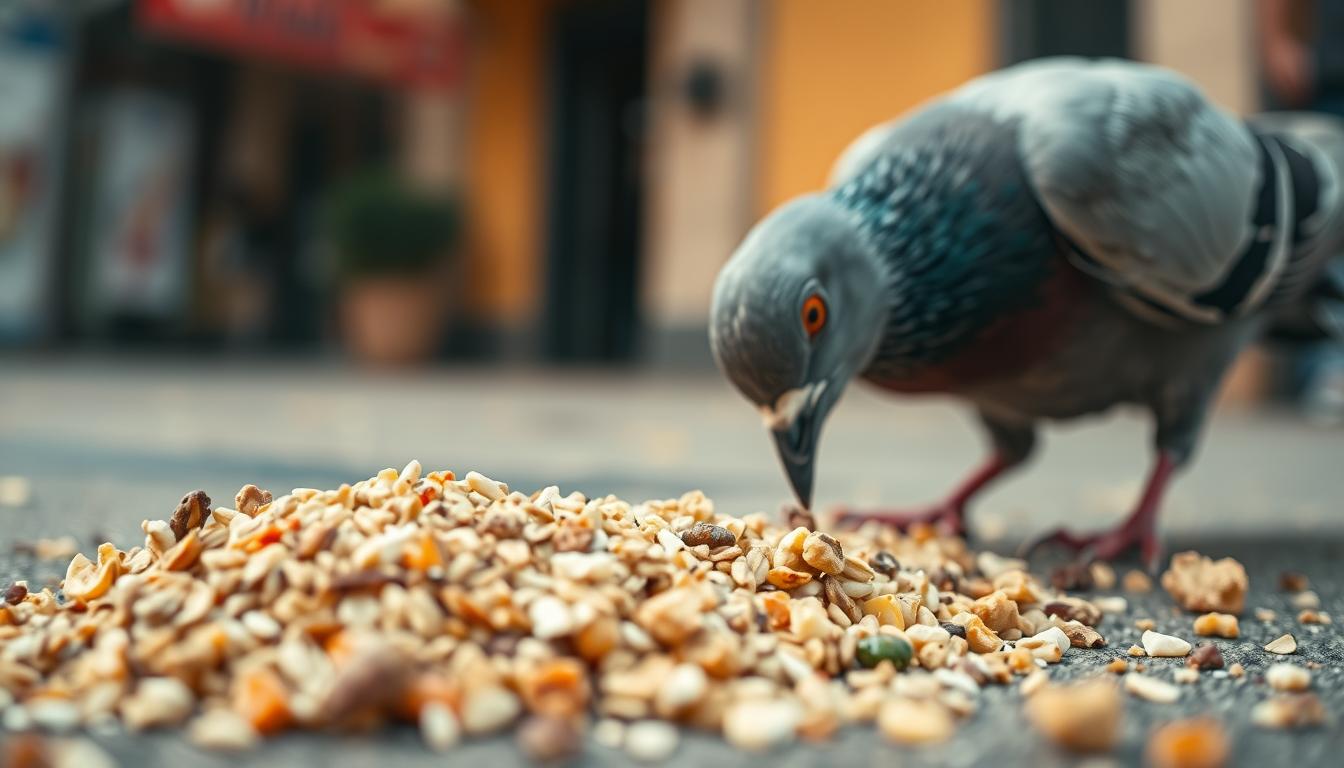Have you ever wondered how something as sweet as chocolate could turn into a nightmare for your cat? Chocolate poisoning in cats is a serious issue that every pet owner should understand. Found in candy, baked goods, and even beverages, chocolate is a common household item that can pose a significant risk to your furry friend.
What makes chocolate dangerous? It contains toxic compounds like theobromine and caffeine, which can harm your cat’s vital organ systems. Even a small amount can be deadly, making it crucial to recognize the signs of poisoning early. Vomiting, diarrhea, and rapid heart rate are just a few symptoms that could indicate your cat has ingested chocolate.
Understanding these risks and knowing how to act quickly can be life-saving for your pet. Stay informed and vigilant to protect your cat from the dangers of chocolate poisoning. The information in this article will guide you through the essential signs to watch for and what steps to take if you suspect your cat has been poisoned.
Table of Contents
Understanding Cats and Chocolate Poisoning
Chocolate poisoning in cats occurs when they ingest substances containing theobromine and caffeine, two compounds toxic to felines. These substances, commonly found in chocolate products, can cause severe health issues.
Toxic Compounds: Theobromine and Caffeine
Theobromine is the primary concern, even in small amounts, while caffeine affects symptoms more at higher doses. Both compounds impact the gastrointestinal, cardiovascular, and central nervous systems.
Caffeine is absorbed quickly, within an hour, while theobromine takes several hours. The severity of poisoning depends on the amount and type of chocolate consumed, with dark chocolate being more dangerous due to higher theobromine content.
Comparative Sensitivity
While dogs are also at risk, cats are more sensitive to these toxins. This heightened sensitivity means even small amounts can be dangerous, making vigilance crucial for cat owners.
Why Cats Are Especially at Risk
Cats are uniquely vulnerable to chocolate toxicity due to their distinct physiology. Their smaller body size and faster metabolic rates make them more susceptible to toxic compounds like theobromine and caffeine found in chocolate.
Unique Sensitivity of Feline Physiology
A cat’s lower body weight accelerates the toxic effects of these substances. Even a small amount of chocolate can be lethal if the cat’s weight is low. For instance, a cat that eats a piece of dark chocolate, which contains higher levels of theobromine, can experience severe poisoning faster than a larger animal.
Cats are usually unaware of the dangers of chocolate. Their natural curiosity often leads them to investigate and ingest items they shouldn’t, which can result in accidental poisoning. As a pet owner, it’s crucial to understand your cat’s vulnerability and take steps to protect them.

Understanding these risks is essential for keeping your pet safe. By recognizing the factors that make cats especially prone to chocolate poisoning, you can take proactive measures to prevent such incidents and ensure your cat’s well-being.
Identifying Common Signs and Symptoms
Recognizing the signs of chocolate toxicity in your cat is crucial for prompt action. These symptoms can vary, ranging from mild discomfort to life-threatening conditions. Understanding these indicators helps you act quickly to protect your pet.
Gastrointestinal and Cardiac Indicators
Gastrointestinal issues often appear first. Vomiting and diarrhea are common signs, indicating mild to moderate toxicity. These symptoms can develop within a few hours after ingestion. Additionally, increased heart rate and abnormal rhythms may occur, signaling cardiovascular distress, especially in smaller cats or those with pre-existing conditions.
Neurological Warning Signs
Neurological symptoms are critical indicators of severe poisoning. Tremors and seizures are key clinical signs that require immediate veterinary attention. These symptoms can develop within 2 hours but may take up to 24 hours to appear, depending on the severity of the poisoning.

Monitoring your cat for unusual behavior is essential. Early detection of these symptoms can prevent severe outcomes. Remember, even small amounts of chocolate can be dangerous, so vigilance is key to your cat’s safety.
Immediate Steps to Take if Your Cat Eats Chocolate
If you suspect your cat has ingested chocolate, it’s crucial to act quickly. Chocolate contains toxic compounds like theobromine, which can harm your cat’s health. Acting fast can make a big difference in your cat’s recovery.
Contacting Your Veterinarian or Poison Helpline
Call your vet or the Pet Poison Helpline immediately. They can guide you on what to do next. Do not try home remedies like making your cat vomit, as this can be unsafe.
Documenting Ingestion Details for Quick Action
Note when your cat ate the chocolate, what type it was, and how much. This info helps your vet give the best care. Symptoms can start within an hour, so quick action is key.
Early help can greatly improve your cat’s chances of getting better. Keep your vet’s number handy and stay calm to ensure your cat gets the care they need.
Treatment Strategies for Chocolate Poisoning in Cats
When your cat ingests chocolate, immediate veterinary care is essential. The treatment approach varies depending on the severity of the case and the amount of methylxanthine compounds consumed.
Veterinary Interventions and Induced Vomiting
A veterinarian may induce vomiting professionally to prevent toxin absorption, especially if the ingestion occurred recently. Activated charcoal is often administered to bind the toxins in the stomach, reducing their absorption into the bloodstream.
Supportive Care: Fluid Therapy and Medications
Fluid therapy is used to maintain hydration and support the cat’s cardiovascular system. Medications may be prescribed to control heart rate and alleviate agitation. The dose of these therapies is carefully calculated based on your cat’s weight and the level of methylxanthine ingested.
Even in a severe case, prompt treatment can lead to a positive recovery. Early intervention is crucial, so contact your veterinarian immediately if you suspect chocolate toxicity.
Preventing Chocolate Ingestion: Keeping Your Pet Safe
Keeping your pet safe from chocolate ingestion requires proactive measures. Chocolate contains compounds that can be harmful to both cats and dogs, making it essential to store it securely.
Safe Storage and Pet-Proofing Your Home
Pet owners should keep all chocolate products in secure, pet-proof cabinets or the refrigerator. Cats and dogs are agile and may jump onto countertops, so storing chocolate out of reach is vital. Using pet locks can help prevent accidental ingestion.
Even if your pet is usually careful, the temptation of chocolate can be high. During holiday seasons, when chocolate is more abundant, extra caution is needed. Safe home practices can greatly reduce the risk of accidental poisoning.
By taking these steps, you can protect your pet from the dangers of chocolate. Remember, prevention is key to ensuring your cat or dog stays safe and healthy.
Conclusion
Chocolate poses a significant threat to your cat’s health due to its toxic compounds. Theobromine and caffeine, found in chocolate, can severely harm your pet’s body. These substances affect the gastrointestinal, cardiovascular, and central nervous systems, leading to dangerous symptoms like vomiting, diarrhea, tremors, and seizures.
The amount of chocolate your cat ingests plays a crucial role in determining the severity of poisoning. Acting within an hour is vital to prevent severe health issues. Your vet may induce vomiting or administer activated charcoal to minimize toxin absorption, ensuring the best chance for recovery.
Preventing chocolate ingestion is key to keeping your pet safe. Store all chocolate products securely out of reach. By creating a safe environment and staying vigilant, you can protect your cat from the risks associated with chocolate toxicity. Remember, quick action can make a significant difference in your cat’s recovery.
FAQ
What makes chocolate toxic to cats?
Chocolate contains compounds called theobromine and caffeine, which are classified as methylxanthines. These substances can be harmful to cats because their bodies metabolize them much slower than humans, leading to toxicity.
How much chocolate is considered dangerous for a cat?
The amount of chocolate that is toxic depends on the type of chocolate and your cat’s weight. Dark and baking chocolates contain higher levels of theobromine than milk chocolate, making them more dangerous. Even small doses can cause symptoms.
What are the early signs of chocolate poisoning in cats?
Common symptoms include tremors, diarrhea, and increased heart rate. In severe cases, cats may experience seizures. These clinical signs can appear within a few hours of ingestion.
What should I do if I suspect my cat has eaten chocolate?
Contact your vet or a pet poison helpline immediately. Provide details about the type and amount of chocolate your cat ingested. Prompt action is crucial to prevent severe health complications.
Can cats recover from chocolate poisoning without treatment?
No, untreated chocolate poisoning can lead to serious health issues. Veterinary intervention, such as induced vomiting or activated charcoal administration, is often necessary to manage the toxicity and support recovery.
How can I prevent my cat from eating chocolate?
Keep all chocolate products out of your cat’s reach. Pet-proof your home by storing treats in secure containers. Educating family members and guests about the risks can also help protect your pet.
Source Links
- Uh Oh, My Pet Ate a Candy Wrapper! What Do I Do? – https://be.chewy.com/pet-ate-candy-wrapper-what-to-do/
- 11 Things You Should Never Do to Your Cat – https://www.petmd.com/cat/general-health/things-you-should-never-do-to-your-cat
- Can Cats Eat Chocolate? What To Do if Your Cat Eats Chocolate – https://www.petmd.com/cat/poisoning/can-cats-eat-chocolate
- Is chocolate poisonous to cats? | Blog – https://www.cats.org.uk/cats-blog/why-is-chocolate-poisonous-for-cats
- Chocolate Poisoning In Cats – https://www.pdsa.org.uk/pet-help-and-advice/pet-health-hub/conditions/chocolate-poisoning-in-cats
- Chocolate Poisoning in Cats: What You Need to Know – https://www.wedgewood.com/blog/chocolate-poisoning-in-cats-what-you-need-to-know/
- Can Cats Eat Chocolate? – https://noblevetclinic.com/blog/can-cats-eat-chocolate
- My Cat Ate Chocolate! Our Vet Explains Toxicity & What to Do – Catster – https://www.catster.com/ask-the-vet/my-cat-ate-chocolate/
- Household Hazards – Toxic Hazards for Cats | VCA Canada Animal Hospitals – https://vcacanada.com/know-your-pet/household-hazards-toxic-hazards-for-cats
- Cat Chocolate Toxicity Calculator – https://www.omnicalculator.com/biology/cat-chocolate-toxicity
- Can Cats Eat Chocolate? Understanding the Risks and What to Do – https://vocal.media/petlife/can-cats-eat-chocolate-understanding-the-risks-and-what-to-do
- Can Cats Eat Chocolate? No! – https://www.pumpkin.care/blog/can-cats-eat-chocolate/
- What To Know about Chocolate Poisoning in Cats and How to Protect Them | Emergency Veterinary Care Centers – https://evcc.com/blog/can-cats-eat-chocolate/
- Vet Advice: Is Chocolate that Bad for Dogs & Cats? – https://www.trupanion.com/pet-blog/article/chocolate-and-pets
- Signs of chocolate toxicity in your dog – https://spca.bc.ca/news/chocolate-toxic-dog/
- Is Chocolate Bad for Cats? – https://basepaws.com/cat-insider/can-cats-eat-chocolate
- Can Cats Eat Chocolate? Chocolate is Toxic to Cats – https://conservationcubclub.com/can-cats-eat-chocolate/
- Can Cats Eat Chocolate? | The Village Vets – https://thevillagevets.com/blog/can-cats-eat-chocolate/




